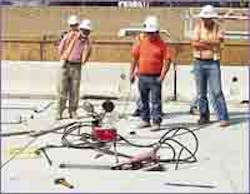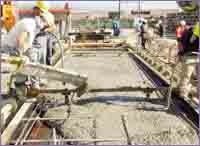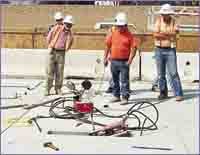Precast, Prestressed Concrete for Instant Pavements
Step with us through the gates of this concrete-casting plant, and take note of a particular casting-bed (form). It's 400 feet long, 10 feet wide and 8 inches deep. Every 36 feet, a bulkhead assembly has been placed across the bed. Six cable-like steel tendons pass through holes in the bulkheads and are attached at the ends of the bed. Before being anchored at the far end, however, the tendons were stretched to nearly 80 percent of their ultimate strength and secured in that state. Notice also that every 2 feet, a small-diameter tube has been placed across the width of the bed, at right angles to the tendons.
Stand back, now, as tons of quick-setting concrete are poured into the bed, consolidated and hand finished. When the concrete has set sufficiently, the tendons, which are exposed at the bulkheads, are severed. At once, the tendons try to return to their original length, and as they pull in on themselves, they create enormous "compressive" forces in each of the 36-foot-long "panels."
These forces are akin to pressing as hard as you can with the heels of your hands against opposite ends of a row of books. Press hard enough, and you can lift the entire row off the shelf. The compressive forces induced in the concrete panels make them stiffer and better able to resist external forces—like heavy trucks—that will try to bend them during their working life. By pre-tensioning or "prestressing" the panels in this manner, they also can be made thinner, yet will function as well as a much thicker, unstressed panel.
When the panels at the casting yard have cured, they're loaded on trucks and delivered to a road-construction site, at a time when traffic through the site is minimal, usually at night or on the weekend. There, a large rough-terrain crane picks the panels off the trucks, then places them edge-to-edge over a 2-inch asphalt leveling course. Plastic sheeting over the asphalt reduces friction as the panels slide into place. The panels actually fit together with a tongue-and-groove-like keyway, which is epoxy-coated for a more secure joint.
As the panels are installed, you begin to see that their 36-foot width is forming a new pavement with two driving lanes and a shoulder. Those tubes placed in the concrete at the casting yard are now also lining up end-to-end, forming continuous ducts through the panels. Into these ducts are threaded steel tendons, similar to those imbedded in the concrete at the casting yard.
The tendons, which may pass through 15 or more panels, are anchored at one end, pulled taut with a powerful jack from the other, and secured. This process, called "post-tensioning," creates a compressive force through the panels in the new pavement's longitudinal direction, complementing the prior pre-tensioning at the casting yard in what is now the pavement's transverse direction.
The process thus described is an experimental technique for rapidly building or repairing roads in high-traffic areas. So far, the technique has been used on two projects—a 248-linear-foot section of a southern California Interstate (I-10, near El Monte), completed in mid-2004, and a 2,300-linear-foot section of pavement near Austin, Texas, completed in 2002.
At present, two additional projects are in the works, one in Missouri and another in Texas, says David Merritt, P.E., project manager for The Transtec Group, an Austin-based engineering and research firm specializing in pavements. The firm was awarded the FHWA (Federal Highway Administration) contract for design and construction support on the California project, and will serve in a similar capacity for the upcoming projects.
The original Texas project, says Merritt, resulted from a feasibility study initiated by the FHWA and completed by the Center for Transportation Research (CTR) at the University of Texas (Austin). Says Merritt—who worked for CTR at the time and was a member of the feasibility-study and implementation team—the success of the initial project in Texas led to the California project. Both roadways, he says, are performing successfully.
Actually, three different types of concrete panels are used in the technique: base panels, central-stressing panels and joint panels.
Base panels are uniform slabs cast with pre-tensioning tendons and post-tensioning ducts. Central-stressing panels are similar in design, but have surface slots, or pockets, which allow feeding in the post-tensioning tendons. Joint panels serve both as an expansion point between post-tensioned pavement sections and as anchors for the post-tensioning tendons. Joint panels are built in halves, with stainless-steel dowels running between the halves.
Although the following quick description would not be the actual sequence of construction, imagine a section of precast pavement that begins with two central-stressing panels, placed edge-to edge. Then, 10 base panels are placed adjacent to each central-stressing panel. At the end of each base-panel set is a joint panel.
Each pocket in the central-stressing panels allows the installation of two tendons, which run in opposite directions through a different set of 10 base panels. When the tendons reach their respective joint panels, they secure themselves in self-locking anchors.
A post-tensioning jack is now installed in a central-stressing-panel pocket near the center of the pavement. The jack uses a "dog-bone" connector that allows pulling both tendons taut, simultaneously. When these tendons are secured, the jack is moved to the next slot (which is 2 or 3 feet away), repeating the process. Post-tensioning continues outward toward the edges of the pavement, alternating the jack side-to-side.
In reality, the panels are placed in a specific sequence. Were a precast pavement to be the continuation of an existing pavement, for example, one side of a joint panel likely would be first mechanically tied to the existing structure. Then would follow, in sequence, the other half of the joint panel, multiple base panels, the central-stressing panels, another set of multiple base panels and a joint panel. (Actually, the joint panel halves are held together and installed as one piece.)
Then, the post-tensioning tendons would be inserted and the entire assembly pulled together from the central-stressing panels. Filling the tendon ducts, stressing pockets and any under-panel voids with grout would complete the installation.
We've skipped over some details, of course. For instance, while panels were, indeed, cast 10 at a time in Texas, the casting bed in California handled only two 37-foot-long panels. An asphalt base was used in Texas, but lean-concrete in California. (Base material, says Merritt, is a work in progress, but asphalt seems more forgiving.) The 10-inch-thick panels used in California were only 8 feet wide (to meet transport regulations), and the number of panels post-tensioned together ranged from 16 in California to 25 in Texas. Also, the California joint panels did not have self-locking anchors, and a bit of diamond grinding was required to attain ride specifications on the California pavement.
According to Merritt, the controlled environment in which the concrete is cast, the pre-tensioning and subsequent post-tensioning all combine to give precast, prestressed pavement the potential for long life. Design-life projections are a sticky subject, but estimates are that the California pavement could last 50 years or more, based on anticipated traffic increases.
Although the cost per square yard of both the Texas and California pavements was 4 to 5 times that of conventionally placed concrete, proponents of the technique say that larger projects would bring an economy of scale that should help cut costs significantly.
The real savings, they say, are in reducing "user-delay costs" which, according to some estimates, can be 10 to 20 times higher in work zones with 24-hour-per-day lane closures, compared to work zones with short night-time or weekend closures. Also on the plus side are the rapid deployment of the pavement sections and the prospect of extending the construction season. The road-building industry will follow with interest the two upcoming projects.




